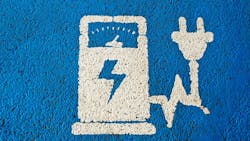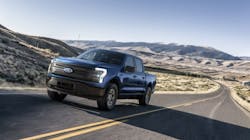In the 2023 Water Report, Black & Veatch polled more than 450 qualified U.S. water utility stakeholders about their climate mitigation strategies. Forty-eight percent of respondents selected “conversion of fleet vehicle(s) to EVs,” up from 29% the previous year. Many cited clean air regulations, utility sustainability goals and community sustainability initiatives as key drivers of fleet electrification. Many utilities also see financial benefits when electricity becomes their new fuel or from grants and other incentives that offset the cost of vehicles and charging equipment.
Electric vehicle considerations for water and wastewater utilities
A customized strategy and roadmap help water utilities account for make-or-break factors such as equipment options, charging strategy, energy reliability, total cost of operation, emission reductions and available incentives. A strong plan allows water utilities to perform critical missions that are aligned with sustainability and regulatory goals for a cleaner community.
While operability and the ability to effectively charge vehicles is key, it is also important to address other elements such as:
- Water utility staff training to operate and maintain electric charging equipment;
- Electric utility interconnection process and timeline;
- Reduction in greenhouse gases or sustainability impact; and
- Community benefits and impacts.
Incorporating these elements results in a comprehensive fleet electrification roadmap that evaluates and addresses operability, organizational change, equity, financial, and sustainability considerations for a variety of utility and community stakeholders.
The roadmap guides the transition to an electrified fleet that maximizes benefits while mitigating the costs and the disruptions to operations and the organization.
Heavy duty electric vehicles
Thinking expansively about operations is also important. It is not just about light-duty vehicles anymore. Zero-emission, heavier-duty vehicles and equipment are evolving to match conventional, internal combustion engine vehicles and equipment.
Incorporating all types of vehicles and equipment into the roadmap will ensure that utilities can effectively achieve electrification over time, while also retaining the ability to accomplish the multitude and variety of tasks that are unique to water utilities. A highly reliable charging network is required, as these vehicles are mission critical to business operations.
Water and wastewater utilities set example for going electric
Water utilities are making bold moves to electrify. In response to recent California Air Resources Board regulations, the Helix Water District in San Diego County is working with Black & Veatch to plan and design the EV charging infrastructure at its main operations center. This project will add approximately 80 charging stations to support the water district’s transition to a primarily electric fleet of vehicles and equipment over time.
Black & Veatch is also helping a large metropolitan wastewater utility plan to convert most of its fleet to electric vehicles by approximately 2030. The plan includes a vehicle energy use analysis, EV charging assessment, electric utility rate analysis and conceptual charging infrastructure layouts at several sites. It also includes a timeline reflecting when EV purchases and associated charging equipment will need to be made to maintain effective operations.
These and other water sector examples reflect that electrification is gaining traction across multiple sectors, which creates a competitive marketplace for ideal charging sites, equipment supplies and utility interconnections. With a clear strategy, water utilities can build a transparent, month-to-month deployment schedule that hits all the critical milestones, while presenting the costs and benefits of fleet electrification in a clear and concise way.
Part of the value of planning ahead is to order equipment early to avoid supply chain issues and to reap the cost efficiencies of building out at one time versus incrementally over time, which costs more.
Growth and incentives support EV transition
Various independent sources project a significant increase in EV demand over the next decade — double-digit annual growth percentages in some instances.
Technology improvements, additional electric vehicle models, financial incentives and other advancements are leading the move forward. The trends suggest that water utilities considering fleet electrification will not be alone.
Automakers meet demand for EV adoption
Major U.S. automakers are producing more EVs for consumers and fleet customers in response. More EVs on the road create an urgent need for more charging infrastructure. As a result, a multitude of EV supply equipment (EVSE) companies are developing hardware and software products to charge vehicles more efficiently and effectively. There are more types of vehicles and associated technologies entering the market, which should provide water utilities with greater choice and cost competitiveness.
Federal government drives EV technology
The federal government is investing in EV technology to incentivize EV use as well. This includes billions of dollars to construct public EV charging stations, tax credits for EV purchases and investment to improve the electric battery supply chain. State and local opportunities may also be available — grants, rebates or other incentives — to help utilities obtain funding to afford vehicles or charging infrastructure.
Many electric utilities are also offering programs that provide business or utility customers with EV charging rebates or general support with understanding electric service impacts and other key considerations when transitioning to an electric fleet. These financial incentives, paired with an increasing variety of vehicles, equipment and technologies, should sustain the momentum toward a growing EV market. Water utilities can incorporate these financial incentives and choices into their roadmap to balance operability, financial and sustainability considerations.
The wider influence of fleet electrification
Fleets make up a small percentage of registered vehicles but have a major influence on the transportation sector and local communities. When utilities, businesses and governments electrify their fleets, the impact has a positive ripple effect across multiple industries.
- Technology drives continuous improvement. The electric vehicle industry continues to innovate, and new EV technologies and uses such as bi-directional charging can enhance operations and resilience.
- Reduced tailpipe emissions improve air quality. Utility service areas can be widespread and the reduction of emissions on communities can be significant.
- Fleet electrification can save money. Net savings from reduced fuel and maintenance costs can save utilities money and have a positive financial impact to ratepayers over time.
Fleet electrification highlights the importance of the water and energy nexus. As companies move beyond pilots to commercialization while progressing their decarbonization objectives, they are supported by vehicle original equipment manufacturers (OEMs) who continue to release new EV models; electric utilities who are preparing the grid for more distributed solutions; and governments, who are incentivizing the transition.
They get support from technology integrators and infrastructure experts like Black & Veatch, too, whose best practices and experience lead to effective EV charging strategies, plans, designs and deployment.
About the Author
Michael Borchers
solutions director for strategic growth initiatives for Black & Veatch
Michael Borchers is a solutions director for strategic growth initiatives for Black & Veatch’s governments and environment business sector. In this role he is responsible for developing and implementing strategies and solutions for water, wastewater and other governmental clients to increase their overall resilience and become more sustainable through the use of renewable energy sources, zero-emission vehicles and other technologies that balance operational performance with reduced carbon impact. Borchers has more than 20 years of experience in the water industry, including time in utility management, as well as management consulting where he has focused on helping clients develop and implement business strategies to provide quality water service.

